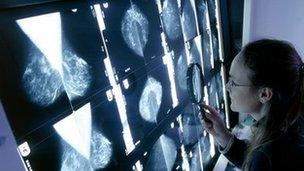Viewpoint: Weighing the pros and cons of breast screening
- Published

Some experts are concerned about "overdiagnosis"
The Independent Breast Screening Review Panel should be commended for the work that they have done.
In particular they have highlighted the fact that breast cancer screening is associated with both benefits and harms.
They also emphasised that women should be told about the benefits and the harms so that they can make an informed choice about whether breast screening is right for them.
What the evidence tells us is that breast cancer screening will reduce a woman's chance of dying from breast cancer - from about 23 in 1,000 to 19 in 1,000 for a 50-year-old woman.
What is the price of that benefit?
For every breast cancer death that is prevented, three women will be diagnosed with a cancer that would never have become apparent in their lifetime.
These women will be treated unnecessarily for breast cancer and those treatments my result in harm.
For example, women who are screened are more likely to end up having a mastectomy than women who are not screened.
And some treatments, such as radiotherapy, will increase a woman's chance of dying from something other than breast cancer.
Making a choice between these different harms and benefits is not easy.
Many women will decide that a small reduction in the chance of dying from breast cancer is worthwhile. Others may decide that the small benefit is not worth the inconvenience of going for mammography and the increased chance of having unnecessary treatment.
What is clear, is that either choice is a reasonable one.
Dr Paul Pharoah is professor of cancer epidemiology in the departments of oncology and public health and primary care at the University of Cambridge
- Published30 October 2012
- Published30 October 2012
- Published30 October 2012